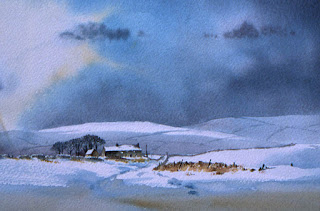This seems like the wettest January I’ve ever experienced, but even so there have been 3 or 4 absolutely fabulous days of glorious sunshine, blue skies and hardly a breath of wind, which shows that if we wait for them, and have all our art gear ready to go, we can take advantage of some beautiful spring-like days even in the wettest of Januarys. I’ve had some marvellous moments sketching in the hills lately, but all too brief.

Anyway, in anticipation of some snow (much to the neighbours’ concern we’ve been invoking the little-known snow-making ritual in the garden, but so far only attracted further deluge), I shall just cover a few basic points to help you with your snow scenes. This painting of a Herefordshire scene in late winter I did many years ago. I began by making the sky dark enough to highlight the snow-covered roofs, which were left as white paper. Even so, the cloudless sky suggests a fine day. To avoid the scene appearing too cold all over, I emphasised the red-brick walls of the buildings, and this also draws the eye to them as the centre of interest.
Clods of earth from the ploughed ruts peek up through the snow, and I have re-arranged them slightly to aim towards the buildings. The field under the strong sunshine reflected dazzling white all over, but I wanted to subdue some of this so that the emphasis would be thrown more towards the centre of the composition, so I washed clean water right across the field and then a wash of cobalt blue with a touch of cadmium red over the immediate foreground and to either side. This is a technique you can use quite easily to highlight any part of a painting you wish.
Enjoy the snow when it comes! I must get out into the garden again………….

 This watercolour shows a lonely farm on Tideswell Moor in Derbyshire, where you can find many similar compositions, at times without even needing to get out of your car! While it’s tempting to think of snow as being white, the snow as we see it varies considerably in tone, sometimes appearing almost black when in deep shadow and backlit by strong sunshine. If you wish to push a snowy hill or mountain back into the distance lay a weak wash of blue or blue-grey over it, as you can see on the right-hand distant hill where I used cobalt blue. By comparison the left-hand hill, which is simply the white of the paper, really does come forward. To accentuate the white roof I’ve set it against a mid-tone background: planning your tones like this is easy with some forethought before starting to paint.
This watercolour shows a lonely farm on Tideswell Moor in Derbyshire, where you can find many similar compositions, at times without even needing to get out of your car! While it’s tempting to think of snow as being white, the snow as we see it varies considerably in tone, sometimes appearing almost black when in deep shadow and backlit by strong sunshine. If you wish to push a snowy hill or mountain back into the distance lay a weak wash of blue or blue-grey over it, as you can see on the right-hand distant hill where I used cobalt blue. By comparison the left-hand hill, which is simply the white of the paper, really does come forward. To accentuate the white roof I’ve set it against a mid-tone background: planning your tones like this is easy with some forethought before starting to paint.